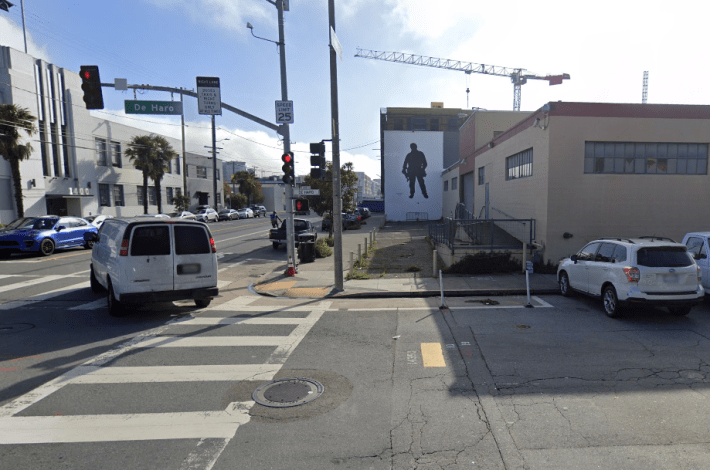Commentary: San Francisco Needs Concrete Solutions to Safety… Literally
4:56 PM PST on November 5, 2019

19th and S. Van Ness where a pedestrian sustained fatal injuries Thursday night. Photo: Google Maps
Note: GJEL Accident Attorneys regularly sponsors coverage on Streetsblog San Francisco and Streetsblog California. Unless noted in the story, GJEL Accident Attorneys is not consulted for the content or editorial direction of the sponsored content.
The San Francisco Board of Supervisors today passed a resolution "Declaring a State of Emergency on Pedestrian and Cyclist Fatalities in San Francisco." This comes on the heels of yet another death on the streets: a pedestrian was killed at 19th Street and South Van Ness on Thursday. That's the sixteenth person killed while walking or biking this year.
And Saturday morning a pedestrian was severely injured at 16th and de Haro.
Supervisor Matt Haney, one of the authors of the resolution, wrote Streetsblog to declare that "San Francisco must take immediate, sweeping action to address the very real and very serious safety concerns of people walking and biking in our city." He added that the city must "...enforce speed limits, add more red-light cameras...." and "...re-time traffic lights for safety rather than speed."
Of course, Streetsblog welcomes such measures. But adding another resolution, executive order, or whatever, kind of sidesteps the bigger issue: it isn't that the city isn't working on safety treatments.
It's that, so far at least, they're not working.

Notice the "safe-hit" posts and painted day-lighting at the intersection of 16th and De Haro, scene of Saturday's horrific crash. Sixteenth has an ongoing improvement project, but it already got safety treatments from SFMTA two years ago. The disturbing fact is that we're starting to see more and more crashes happening right where recent safety projects are already installed. Think of September's crash in the Tenderloin, where a "scramble" safety installation went in--followed by a drunk driver seriously injuring a small boy in the crosswalk.
The problem is too many people responsible for street safety still believe in the "Bad Actor Fallacy." That's the view that safety infrastructure should be designed to guide reasonable motorists safely through intersections. Bad Actors, on the other hand--people who speed, drive drunk, run red lights, or are otherwise egregious--are beyond the scope of what infrastructure can do to prevent crashes. We heard this back in 2016, when Heather Miller and Kate Slattery were killed on the same night in separate incidents. The late Mayor Lee and former SFMTA director Ed Reiskin complained that the city had spent millions of dollars to make streets safer and that it was all undermined by the “incredibly irresponsible actions” of the drivers. We heard it again recently after two fatalities, just a few months apart, on Foothill in Oakland--despite the addition of a road diet and lane reductions. An OakDOT official opined that traffic planners can't stop "bad actors."
This is manifest in the widespread use of safe-hit posts, plastic bollards, high-visibility crosswalks, paint treatments, etc. Yes, those help. But, as we know all too well, they fail completely when momentum and the laws of physics intervene: in other words, they're useless against "incredibly irresponsible actions" by a "bad actor" at the controls of a car or truck.
And that's exactly why traffic engineers and planners can't ignore bad actors. In fact, they should be the primary focus.
You mean their SUVs can’t overcome boulders the way the commercials said they would?!? https://t.co/nKBZx92Qph
— Don Kostelec (@KostelecPlan) November 5, 2019
In the tweet above, we see a bad-actor motorist who made a choice to buy an oversized, dangerous vehicle and who drove it too fast and/or without knowing how to judge turning distances. In this case, that motorist was physically prevented from doing harm to vulnerable road users thanks to cheap, simple infrastructure. And it was stone, not plastic, that did the trick. This picture above helps deflect the nonsense that this approach requires great expenditures: boulders are cheap. And it can be used in dense urban areas too; here's a bad actor in Manhattan, featured in Streetsblog NYC, who hit a concrete bollard/pedestrian refuge, which physically prevents - or at least greatly reduces the likelihood of - a reckless motorist killing someone in the crosswalk:

Oddly, we use Jersey barriers and other kinds of hardened infrastructure all the time on roads to keep reckless motorists from killing themselves by driving off bridges, into oncoming traffic, or into the divider of highway. But somehow when it comes to infrastructure to protect vulnerable road users, plastic straws and paint are seen as sufficient.
We need to start using heavy concrete and steel barriers, bollards, blocks and boulders to protect vulnerable road users too. And they need to be placed in front of crosswalks and extended out from corners to form protected intersections that force--not encourage, but force--motorists to take things very, very slowly and carefully.
Let's hope this emergency resolution can starting pushing SFMTA to build infrastructure that deals with bad actors. Because unless we start protecting vulnerable road users with something more serious than overgrown plastic drinking straws, people will continue to die and suffer life-altering injuries--and Vision Zero will fail.
Stay in touch
Sign up for our free newsletter
More from Streetsblog San Francisco
Weekend Roundup: Bancroft Lane Gets Concrete, Party in Downtown S.F.
...and the Bay Bridge to get its lights back
Richmond-San Rafael Bridge Bike Lane Will Need Support
There's no evidence the bike lane contributes to congestion on the bridge
Update on Oakland DOT’s Lakeshore Protected Bike Lane Project
Public seems fairly positive and accepting towards the coming project. Let's hope it stays that way




